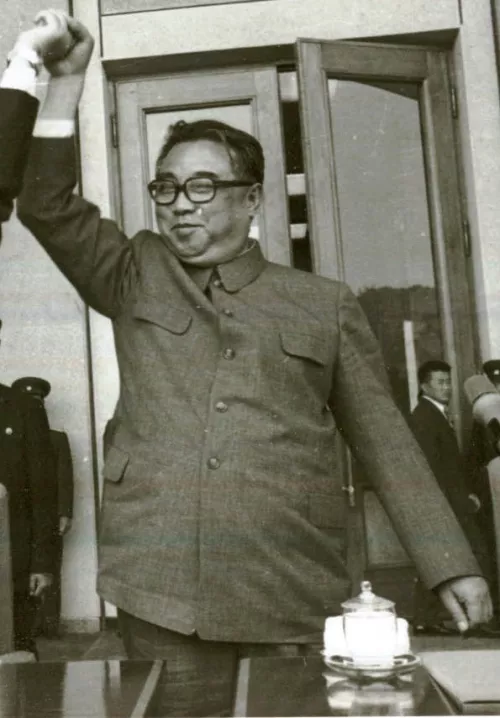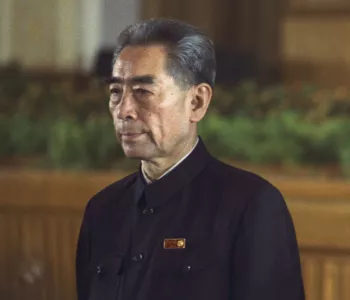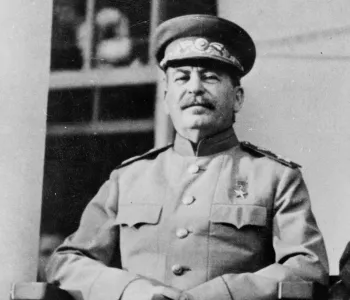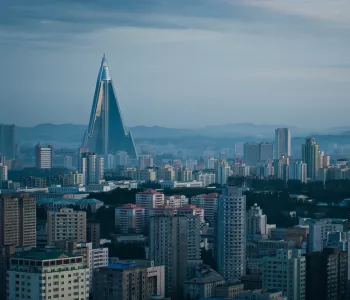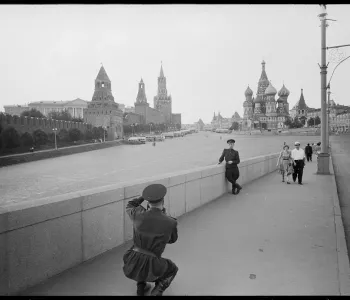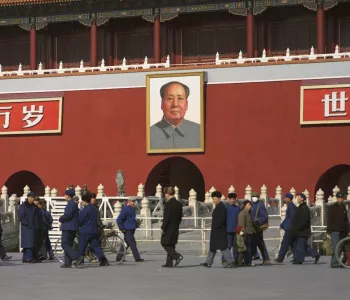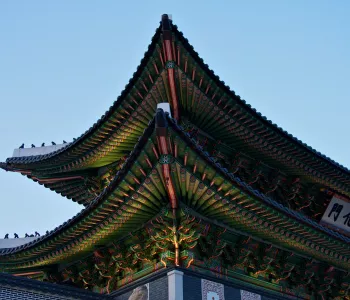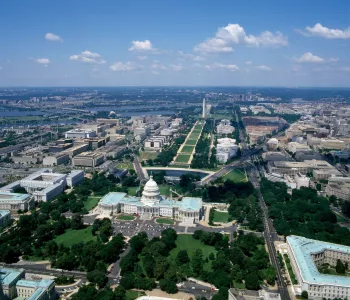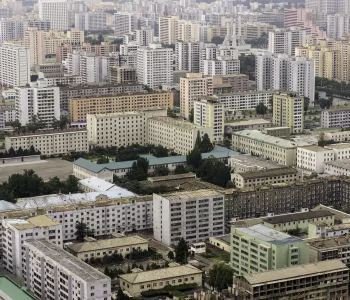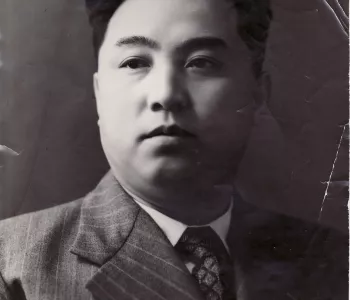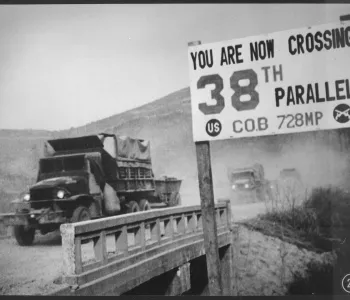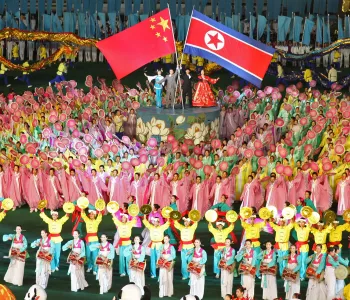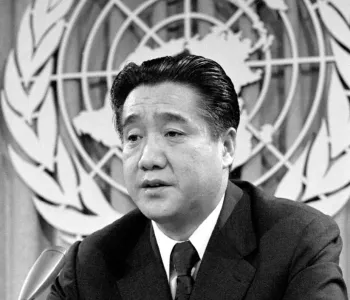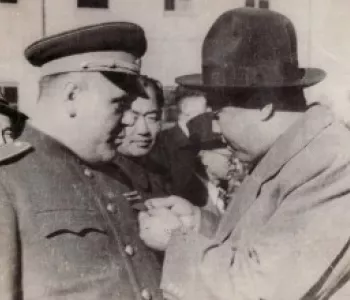Kim Il Sung was leader and ruler of the Democratic People's Republic of Korea from its founding in 1948 until his death in July 1994.
From the post of premier, which he took in 1948 with the formation of the new state and its first administration, Kim was elevated in 1972 to the position of president and head of state. He was also elected general secretary of the Korean Workers' Party (KWP), the top party post, in 1966, after moving upward through successive party positions from 1946. In his later years he was referred to as the "Great Leader."
Kim Il Sung was born into a peasant family that lived in the village of Mangyeongdae in the outskirts of Pyongyang, now described as his native place and a national shrine. In his memoirs, he says that he was actually born in his mother's family house at Chilgok, another village on the outskirts of Pyongyang, and also now a shrine. His original name was Kim Seong-ju. His mother, Kang Ban-seok, was a Christian, and Kim himself admitted that he had attended services as a child, but found them boring. His father, Kim Hyeong-jik, who died in 1926, was a teacher and an occasional practitioner of Goryeo medicine. From 1919 to 1929, Kim's education appears to have been divided between schools in Manchuria and Korea as his family moved back and forth between the two countries. According to official DPRK accounts, Kim traveled alone and on foot from Manchuria to Pyongyang in 1923, returning again, on foot, in 1925. He appears to have been expelled from school in 1929 for unlawful student activities, was imprisoned for a short time, and on release, joined one of the many Korean anti-Japanese guerrilla bands operating from northeast China. There was some liaison between these bands and Chinese communist groups, and Kim also joined the Chinese Communist Party. Around this period he changed his name to Kim Il Sung. In the DPRK, much has been made of his achievements in political organization and guerrilla activity against the Japanese, which are sometimes dismissed as propaganda. But while Kim was by no means the only guerrilla leader among the Koreans, he did rise to some prominence and was the subject of special attention by the Japanese gendarmerie. Under Japanese pressure in 1940-41, many guerrilla groups, including Kim's, retreated into the Soviet Union.
There is no clear record of his activities during World War II, although he appears to have served with the Soviet Red Army in garrison duties in the Soviet Far East. In 1945, following the division of Korea, he returned in Soviet army uniform with many of his former guerrilla colleagues and a number of Soviet Koreans. Kim played no part in the defeat of the Japanese, but he was part of the group that helped to establish the administration in the Soviet-run northern part of the peninsula. Kim does not appear to have been chosen especially for this role; rather, as an able organizer and administrator, he appealed to the Soviet forces. His abilities carried him forward to the reconstruction and reorientation of his country. He appears to have been genuinely welcomed by Koreans as someone with a popular touch and the vigor to get things done. No detail of people's lives was deemed too insignificant for his comment. The reverse of this was a readiness to dominate and control. Whatever the reasons, he had certainly become the dominant political figure in North Korea by the time separate states were established on the peninsula in 1948. He was not yet the all-powerful figure he would later become, but he was well on his way to such a position.
Like most Koreans, Kim was dismayed at the allies' division of Korea, but his attempt to reunify the country through the Korean War ended in failure and continued division. After the war ended in 1953, he concentrated at first on building up his position and that of his family through shrewd and ruthless elimination of political rivals and those judged unreliable, and then on turning the DPRK into an independent socialist entity. The philosophical underpinning of the new state was provided by the doctrine of juche, which emphasized self-sufficiency and self-reliance and the value of the people as the master of their destiny; however, the people needed the appropriate leader to guide them. The economic course he proposed for the DPRK, of agricultural collectivization and rapid industrialization, met with considerable domestic support and initial success. But it proved impossible to sustain its momentum, and from the 1970s, the DPRK began an economic decline, which was reflected in slogans such as "Let's eat two meals a day!" The need for domestic reconstruction, his international supporters' discouragement of renewed military action, and the United States troops in the southern half of the peninsula pushed thoughts of reunification into the background. Instead, a sporadic campaign of terrorism was pursued, aimed at destabilizing the Republic of Korea (ROK). In 1960 and again in 1980, Kim proposed a Democratic Confederal Republic of Goryeo, as a solution to the issue of reunification. In this proposal, which remains the official DPRK position, both Korean political systems would coexist in one state.
From 1971 to 1973, the two Koreas engaged in a dialogue, first through "unofficial" Red Cross talks and then in ministerial-level meetings to discuss ways of moving toward reunification, but the contact fizzled out. In international affairs, Kim steered between the Soviet Union and the People's Republic of China, and the DPRK avoided taking sides in the Sino-Soviet dispute. Kim's ability to see the advantages to the DPRK in various contemporary international trends, such as anticolonialism and the Non-Aligned Movement, coupled with his talent for personal rapport, allowed him to strike up friendships with a number of world leaders, especially in the third world. However, his willingness to pursue a program apparently designed to give the DPRK its own nuclear weapons, despite his repeated statements that there should be no nuclear weapons on the peninsula, attracted the hostility of the United States and nearly brought another war to Korea. He died before the disasters of the mid-1990s that reduced the DPRK to appealing for international humanitarian aid.
Kim is known to have married twice. His first wife, Kim Jeong-suk, also had a guerrilla background. She was known to the Japanese police before 1940 as a member of Kim Il Sung's unit, although not as his wife. They probably married in the Soviet Union in 1940 or 1941; she was apparently known as Vera among the leaders of the Soviet occupation forces after 1945, for whom she would sometimes cook large meals. They had three children, the eldest of which was Kim Jong Il. Kim Jeong-suk was the first lady of the DPRK for one year, from September 1948 until she died while giving birth to a stillborn child in September 1949. She then effectively disappeared from view until Kim Jong Il began to emerge as his father's successor in the 1970s. A monument to her guerrilla activities and a museum were built in her hometown, and her exploits, hitherto ignored, now featured in the media. She continued to receive much attention after Kim Jong Il succeeded his father in 1984.
Kim's second wife was Kim Seong-ae, of whose background little is really known. There is speculation that she had some secretarial role in his entourage. Some accounts say that she was originally a nurse to Kim Il Sung's orphaned children and that they married in 1953. Others give the date of marriage as 1963. Since she began to make public appearances only from about 1965, the later date seems most likely. She regularly accompanied Kim on overseas visits and at state functions. She also appeared, in her own right, as president of the Korean Democratic Women's League, replacing Choe Gwang's wife in 1971, after Choe was purged. She and Kim Il Sung had four children, and there are rumors that she tried to push one of these forward as successor but was unable to stop the rise of Kim Jong Il. Although she appeared on the funeral committees for both Kim Il Sung and O Jin-u in 1994 and 1995, respectively, she made no other known appearances. She was replaced by Chun Yeon-ok as president of the Women's League in 1998 and is said to live under a form of house arrest near Pyongyang, together with other members of her family.
The question of a successor concerned Kim Il Sung greatly. After some years apparently favoring his younger brother Kim Yeong-ju for this role, he switched his preference to his eldest son Kim Jong Il. This was probably in the early 1960s, although the younger Kim remained in the background until he appeared as the designated successor in 1980. When Kim Il Sung died
in 1994, there was no doubt that he had largely fashioned the DPRK, and it remains very much his creation. However, he left the country facing multiple and severe problems, most of which were the result of policies he had insisted on following over the years.
Kim Il Sung continues to dominate the DPRK even after his death. His pictures and statues are everywhere. Since 1998, he is formally called the "Eternal President" and is still referred to as the "Great Leader" (widaehan suryong-a title originally reserved for the Soviet leader Josef Stalin). Children, to whom he is "Grandfather Kim Il Sung," are taught that he is the source of all benefits. His mausoleum at his former place of work, the Geumsusan Memorial Palace, is effectively the national shrine of the DPRK. In 1997, the DPRK formally adopted his year of birth, 1912, as the base date for a new Juche calendar. Elaborate preparations were put in hand to celebrate the centenary of his birth in 2012. Despite the death of Kim Jong Il in December 2011, the events to mark the centenary are to go ahead. Kim Jong Un, Kim Jong Il's third son and designated successor, bears a remarkable similarity to his grandfather.
All rights reserved. No portion of this publication may be reproduced, stored in a retrieval system, or transmitted in any form by any means, electronic, mechanical, photocopying, recording or otherwise without the prior written permission of the publisher. (Historical Dictionary of the Democratic People's Republic of Korea, by James E. Hoare, published by RLPG Books, appears by permission of the author and publisher).
